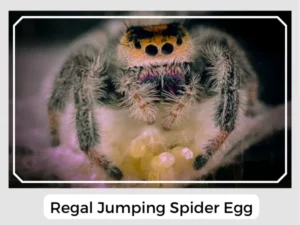The regal jumping spider is a cool member of the Salticidae family. Here’s a fun fact: the boy spiders look so much like black widows because of their color that people sometimes mix them up! Stick around, and we’ll share more awesome things about these jumpy spiders with you!
Usually, female spiders lay eggs four times in their lifetime and the first time the clutch size is around 200. The number of laying eggs decreases with time. All eggs are laid in silk cocoons under pine or oak tree barks.

Photo Credit: Lance Howard
Not much is known about juvenile regal jumping spiders.
These spiders make elliptic webs with two emergency exits on either side, but the webs are not for capturing prey, but rather for fostering their spiderlings and being able to fall back on the webs whenever they jump and miss a target.
Yes, Regal Jumping Spiders have venom. But they mostly use it to catch tiny bugs they like to eat.
They can! If they’re bothered or feel cornered, they might bite. The jumping spider bites only when it is tightly held. It is not poisonous at all, but the bite might give a hurtful sensation that doesn’t last for more than a few minutes.
Regal jumping spiders play a vital ecological role as biological control agents, feasting on a variety of insects that could otherwise become pests. Their behavior is characterized by their hunting strategy, which involves precise leaps to capture prey rather than spinning a web.
Natural Predators: Birds, lizards, and larger spiders are among the natural predators of the regal jumping spider. This predatory relationship is essential in controlling their population and maintaining ecological balance.
Prey-Predator Dynamics: The regal jumping spider’s ability to leap with accuracy allows them to be effective predators of insects, while also evading their own predators. This balance is crucial for the stability of the ecosystems in which they live.
Relationship with Humans: While their bite can be slightly painful, it poses no serious threat to humans. Regal jumping spiders are often welcomed in gardens and farms as they help control insect populations. Their impressive jumping skills have even made them subjects of curiosity.
| Distribution | West Indies, southeastern United States |
| Habitat | Woodland and fields |
| Breeding Season | March-September |
| Diet | Insects |
| Lifespan | 10 months |
| IUCN Conservation Status | Not Listed |
In summary, the regal jumping spider is not only a marvel of nature’s engineering but also a testament to the intricate web of life where each species, regardless of size, has a role to play.
The regal jumping spider is a cool member of the Salticidae family. Here’s a fun fact: the boy spiders look so much like black widows because of their color that people sometimes mix them up! Stick around, and we’ll share more awesome things about these jumpy spiders with you!
Usually, female spiders lay eggs four times in their lifetime and the first time the clutch size is around 200. The number of laying eggs decreases with time. All eggs are laid in silk cocoons under pine or oak tree barks.

Photo Credit: Lance Howard
Not much is known about juvenile regal jumping spiders.
These spiders make elliptic webs with two emergency exits on either side, but the webs are not for capturing prey, but rather for fostering their spiderlings and being able to fall back on the webs whenever they jump and miss a target.
Yes, Regal Jumping Spiders have venom. But they mostly use it to catch tiny bugs they like to eat.
They can! If they’re bothered or feel cornered, they might bite. The jumping spider bites only when it is tightly held. It is not poisonous at all, but the bite might give a hurtful sensation that doesn’t last for more than a few minutes.
Regal jumping spiders play a vital ecological role as biological control agents, feasting on a variety of insects that could otherwise become pests. Their behavior is characterized by their hunting strategy, which involves precise leaps to capture prey rather than spinning a web.
Natural Predators: Birds, lizards, and larger spiders are among the natural predators of the regal jumping spider. This predatory relationship is essential in controlling their population and maintaining ecological balance.
Prey-Predator Dynamics: The regal jumping spider’s ability to leap with accuracy allows them to be effective predators of insects, while also evading their own predators. This balance is crucial for the stability of the ecosystems in which they live.
Relationship with Humans: While their bite can be slightly painful, it poses no serious threat to humans. Regal jumping spiders are often welcomed in gardens and farms as they help control insect populations. Their impressive jumping skills have even made them subjects of curiosity.
| Distribution | West Indies, southeastern United States |
| Habitat | Woodland and fields |
| Breeding Season | March-September |
| Diet | Insects |
| Lifespan | 10 months |
| IUCN Conservation Status | Not Listed |
In summary, the regal jumping spider is not only a marvel of nature’s engineering but also a testament to the intricate web of life where each species, regardless of size, has a role to play.